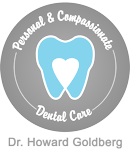Periodontal Therapy
Gingivitis & Periodontitis
Gingivitis and periodontitis are gum diseases caused by a proliferation of bacteria along and beneath the periodontal tissues. Gingivitis is the mildest form of periodontal disease, beginning with minor symptoms like gum inflammation. Although it is highly treatable, gingivitis is often left untreated and allowed to progress into an advanced stage of a periodontal disease known as periodontitis. Though still treatable, periodontitis requires more invasive treatments to prevent total tooth loss. The symptoms of gum disease may include:
- Red and/or swollen gums
- Gum tenderness
- Gums that easily bleed
- Persistently bad breath
- Receding gum line
- Gums that have pulled away from the base of the teeth, forming “pockets”
- Loose teeth
Did you know…that gingivitis and periodontitis are both highly preventable diseases? Although at least half of the U.S. adult population suffers from some form of gum disease, many could have prevented it by brushing and flossing regularly, as well as visiting the dentist for periodic exams and professional teeth cleanings. Avoiding bedtime snacking or consuming foods that are high in sugar can also prevent the onset of periodontal disease, as can avoiding tobacco products, such as cigarettes. |
Frequently Asked Questions
Do I need treatment for gingivitis or periodontitis?
If you are experiencing any symptoms of gum disease, seek treatment immediately. Failure to treat a periodontal disease can allow the condition to progress, eventually causing irreversible damage, such as tooth loss.
Causes of Periodontal Disease
Did you know?In addition to poor brushing and flossing habits, several other factors can contribute to the development of gingivitis and periodontitis. They include:
|
Frequently Asked Questions
What should I do if I have some of the risk factors of periodontal disease?
If you have one or more risk factors for periodontal disease, it is especially important that you visit your dentist for periodic exams. A thorough examination can reveal gingivitis in its early stages, allowing for easier and more conservative treatment options. If you are experiencing symptoms of periodontal disease, such as gum inflammation or bleeding, schedule an appointment immediately.
Non-Surgical Periodontal Therapy
There is a wide range of procedures at the disposal of dentists for the treatment of periodontal diseases and conditions, and we want to provide the most minimally invasive and cost-effective option for you. Often, this means that patients can undergo non-surgical treatments to restore periodontal health, more specifically something referred to as scaling and root planing. This procedure is used to remove bacteria and built-up tartar from deep within the gum pockets surrounding the teeth. It usually involves supplemental therapy, such as the use of topical antibiotics.
Frequently Asked Questions
Am I a candidate for non-surgical periodontal therapy?
Only your dentist can tell you if you are a candidate for non-surgical periodontal therapy. However, non-surgical treatments are typically only available to patients with mild to moderate periodontal disease. Schedule a consultation with your dentist to find out if non-surgical treatment is right for you.
What should I expect during a non-surgical periodontal therapy?
During this procedure, you’ll be given a local anesthetic to prevent discomfort, and small, thin instruments will be used to remove tartar and smooth the root surfaces of your teeth to prevent bacteria build-up.
Will I need to follow any special instructions following non-surgical periodontal therapy?
In the days following your scaling and root planing treatment, you may experience heightened tooth sensitivity. Use a sensitivity toothpaste and try to eat only soft foods to prevent pain. If you were prescribed antibiotic, be sure to take it according to your dentist’s instructions.
Arestin
The number one cause of tooth loss is not decay or trauma – it’s periodontal disease. Periodontal disease, or gum disease, is an infection of the gum line that causes inflammation and bleeding. Left untreated, it can also cause the gums to recede and begin to pull away from the teeth. Arestin is a solution to periodontal disease. When used in tandem with a root scaling and planing, Arestin can help halt moderate to severe gum disease in its tracks. It is a topical antibiotic placed deep into the gum pockets, where it works to kill the bacteria responsible for gingivitis and periodontitis. The medication is administered by a dentist or dental hygienist, and its time-release formulation continues to kill bacteria for several days after application.

Frequently Asked Questions
Do I need Arestin treatment?
You may need Arestin if you are diagnosed with moderate to severe periodontal disease. If you suspect that you could be suffering from gum disease, see your dentist immediately for an examination and consultation.
What should I expect from Arestin?
Arestin is highly effective for destroying the bacteria that causes gum disease. However, it is possible that you will require additional treatments.
Are there any steps I need to take after being treated with Arestin?
In the initial week to 10 days following Arestin treatment, you will need to avoid consuming hard, crunchy, and sticky foods such as candy and gum. You should also temporarily eliminate flossing from your dental routine. At the end of the treatment period, you may resume flossing and are encouraged to stop smoking (if applicable), as this can increase your risk of developing periodontal disease again in the future. So long as you adhere to a careful and hygienic dental routine, you should be able to prevent future incidences of gum disease.















